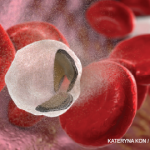Rheumatologists are in the unique position of diagnosing and treating rare auto-inflammatory and autoimmune diseases. Although systemic lupus erythematosus (SLE) often has textbook presentations, it is a heterogeneous condition with a wide variety of disease manifestations.
In 2019, the European League Against Rheumatism and the ACR introduced new classification criteria to help diagnose this condition.1 These criteria use a point-based system to demonstrate an increased likelihood a patient has lupus.
We present a case that illustrates the importance of maintaining a high index of suspicion for lupus with unusual clinical presentations, because these presentations can sometimes be life-threatening.
Case Presentation
AB is a 30-year-old Black woman with a past medical history of asthma who was transferred to a tertiary care center with dyspnea, fevers, anemia and thrombocytopenia.
Her symptoms began about three months prior to presentation. At that time, she went to the emergency department with menorrhagia and was found to have anemia and severe thrombocytopenia, with platelets less than 5 k/µL. She was treated immediately with high-dose, intravenous (IV) dexamethasone and one dose of 1 g/kg IV immunoglobulin. During that admission, she was noted to have left-sided inguinal lymphadenopathy and, ultimately, underwent a lymph node biopsy, which showed reactive changes without any evidence of malignancy. Her thrombocytopenia and anemia resolved.
Approximately two months prior to her current admission, she presented to an urgent care facility with a weeklong history of headaches and fevers. A computed tomography (CT) scan of her head and a lumbar puncture were unremarkable. She was found to have thrombocytopenia again and started on 60 mg of oral prednisone daily. Her thrombocytopenia improved. Her headaches were diagnosed as migraines and resolved with analgesics.
One month prior to this admission, her outpatient hematologist had noted progressive anemia and thrombocytopenia despite high-dose oral steroids and initiated 375 mg/kg2 rituximab for four weekly doses. Her second weekly infusion was held because the patient had developed fevers and malaise. She was admitted to the hospital and subsequently transferred to a tertiary care center after her hemoglobin was found to be 3.7 mg/dL.
Her past medical history was notable for congenital hip dysplasia and uterine fibroids. The remainder of a review of systems was notable for dry mouth, palpitations and abdominal bloating. She had no significant family history and denied tobacco, alcohol or drug use. The patient had no prior pregnancies, miscarriages or abortions. Her only drug allergy was morphine.
On exam, her heart rate was 140 beats per minute and regular. Her blood pressure was 120/68 mmHg. Her respirations were 20 per minute, and she was febrile, with a temperature of 102.9°F (39.4°C). Her oxygen saturation was 99% on room air. Her physical exam was notable for regular tachycardia without murmurs, oral thrush, mild frontal alopecia, and non-tender anterior cervical and axillary lymphadenopathy. Her lungs were clear to auscultation, and her abdominal exam was normal.
Her anti-nuclear antibodies were positive at 1:640 with a speckled pattern. Her anti-cardiolipin IgM antibody was mildly elevated at 12.9 MPL, and her IgG antibody was negative. Her anti-β-2 glycoprotein IgG and IgM antibodies were negative.
Lupus anticoagulant screening and confirmatory dilute Russell viper venom time test were both positive. Other positive labs included elevated anti-ribonucleoprotein antibody at 130 units (normal <20 units) and anti-Smith antibody at 52 units (normal <20 units). Her autoimmune studies were otherwise negative, including antibodies against double-stranded DNA and DNA (Crithidia), SSA, SSB, Scl-70, cyclic citrullinated peptide and Jo-1.
Her complements were low. Coombs testing was positive, and labs were consistent with hemolysis (i.e., lactate dehydrogenase enzyme was elevated at 1,206 U/L and haptoglobin was less than 15 mg/dL). An infectious workup showed possible pneumonia on a chest X-ray with lower lobe consolidations. She had negative blood and urine cultures, but did not have serologic evidence for hepatitis, cytomegalovirus, Epstein-Barr virus, human herpesvirus-6, parvovirus B19 PCR, mycoplasma, human immunodeficiency virus, Bartonella, Brucella, or histoplasmosis and blastomycosis antigens. Urine pregnancy testing was negative.
Table 1 shows the patient’s laboratory findings.
| Three months prior | Two months prior | Current admission | |
|---|---|---|---|
| WBC (K/UL) | 3.6 | 7.4 | 13.2 |
| Hemoglobin (g/dL) | 8.3 | 6 | 3.7 |
| Platelets (K/UL) | 5 | 85 | 323 |
| Creatinine (mg/dL) | 0.87 | 0.67 | 1 |
| AST (IU/L) | 36 | 43 | 59 |
| ALT (IU/L) | 32 | 43 | 41 |
| Albumin (g/dL) | 3 | 3.48 | 2.4 |
A bone marrow biopsy of her left iliac crest showed bone marrow that was 80–90% cellular with progressive trilineage hematopoiesis. A peripheral smear showed macrocytic anemia. Positron emission tomography scan revealed multiple diffuse hypermetabolic lymph nodes, and a CT scan demonstrated hepatosplenomegaly.
She was started on IV cefepime and vancomycin, oral metronidazole and inhaled nebulizers. The patient was also started on 1 mg/kg/day of methylprednisolone for three days. She received transfusions of platelets and red blood cells. Her blood counts improved over the course of a week with corticosteroid administration, and she was also given a dose of rituximab 375 mg/kg with plans to continue this treatment as an outpatient. She was discharged to follow-up on 60 mg of prednisone daily.
Discussion
Evans syndrome is an autoimmune disorder characterized by autoimmune hemolytic anemia and immune thrombocytopenia.2 The disorder is characterized as either a primary, idiopathic syndrome or secondary to another condition, often autoimmune or congenital.3
In 1951, Robert S. Evans, MD, and colleagues reported a series of patients with varying manifestations of anemia and thrombocytopenia.4 In their cohort of 29 patients, they showed five categories of presentation: 1) hemolytic anemia without thrombocytopenia, 2) hemolytic anemia with thrombocytopenia but no purpura, 3) hemolytic anemia with thrombocytopenia and purpura, 4) thrombocytopenic purpura with sensitized red cells, and 5) thrombocytopenic purpura without sensitized red cells and no anemia. Most patients were women. Only one of the patients had systemic lupus erythematosus.
The researchers hypothesized “the activity of an immune body brings about increased destruction of thrombocytes by agglutination and phagocytosis and might also decrease thrombocyte production …,” which may cause Evans syndrome. To date, the pathophysiology of Evans syndrome is not known. Abnormalities in many various immunomodulatory cells have been reported, including alternations in Th1 and Th2.5
Evans syndrome as the initial manifestation of lupus is quite rare, but has been described in a few case reports, particularly in young women.6 In a large, retrospective study of 850 pediatric patients in Brazil, only 1.3% had Evans syndrome at the time their lupus was first diagnosed.7
In another retrospective, single-center study, 2.7% of 953 patients with SLE were also diagnosed with Evans syndrome.2 In this cohort, patients who presented with Evans syndrome as the initial manifestation of SLE had severe, life-threatening multi-organ involvement. This is similar to our patient, who presented with severe anemia and thrombocytopenia.
Symptoms of Evans syndrome include those that are seen typically with anemia, such as fatigue, pallor and dyspnea, and those of thrombocytopenia, namely bleeding, easy bruising and petechiae.8 A high clinical suspicion is imperative for diagnosis. In addition to such basic laboratory tests as complete blood count, diagnostic tests looking for elevated lactate dehydrogenase, low haptoglobin, and peripheral blood smears showing spherocytes can point toward evidence of hemolysis.8
As with many life-threatening rheumatologic conditions, corticosteroids are required at first to rapidly put Evans syndrome into remission. Prednisolone doses range from 1–2 mg/kg/day, and can be up to 6 mg/kg/day.8 Steroids alone, however, are not often enough to place patients into remission, especially those with severe manifestations. A retrospective review showed that of 68 patients with Evans syndrome, only 27% of patients achieved clinical remission with steroids alone.9
Due to a paucity of randomized clinical trials in this rare disease, the choice of second-line immunosuppressive agent in Evans syndrome is often at the discretion of the treating provider. Second-line therapies used for Evans syndrome related to lupus include intravenous immunoglobulin, rituximab, mycophenolate and plasma exchange. Sirolimus and cyclosporine have shown promise in certain cases. Case reports also describe the use of the 26S proteasome inhibitor bortezomib in patients with concomitant lupus, Evans syndrome and antiphospholipid syndrome.10 Danazol, a heterocyclic steroid, has been used successfully in patients, including those with thrombocytopenia refractory to splenectomy. Thrombopoietin receptor agonists, such as romiplostim or eltrombopag, have been anecdotally reported in children with severe, refractory Evans syndrome.8
In particular, rituximab has been shown to have excellent utility in treating lupus-related cytopenias in a multicenter retrospective study. In this study, 71 patients with SLE-associated immune cytopenias were treated with rituximab, with an overall response rate of 86%. In the 10 patients with Evans syndrome related to SLE, the response rate was lower, at 60%, but still favorable. Rituximab was also found to be a safe treatment, with only three of 71 patients developing severe infections and no fatalities.11 This is why rituximab was chosen as second-line therapy in our patient.
The patient was seen approximately two weeks after discharge from the hospital. At this time she was feeling well, and her labs had shown significant improvement, with a hemoglobin of 10.2 g/dL, and platelet count of 185 k/µL. She was started on hydroxychloroquine at that time, prednisone was tapered, and she continued outpatient rituximab infusions through a local hematologist.
 Matthew J. Herrmann, MD, is a recent rheumatology fellowship graduate from Loyola University Medical Center, Illinois. He is currently in practice at HonorHealth, Arizona.
Matthew J. Herrmann, MD, is a recent rheumatology fellowship graduate from Loyola University Medical Center, Illinois. He is currently in practice at HonorHealth, Arizona.
 Faizah Siddique, MD, is an assistant professor of medicine in the Division of Rheumatology, Allergy, and Immunology at Loyola University Medical Center.
Faizah Siddique, MD, is an assistant professor of medicine in the Division of Rheumatology, Allergy, and Immunology at Loyola University Medical Center.
References
- Aringer M, Costenbader K, Daikh D, et al. 2019 European League Against Rheumatism/American College of Rheumatology classification criteria for systemic lupus erythematosus. Arthritis Rheumatol. 2019 Sep;71(9):1400–1412.
- Costallat GL, Appenzeller S, Costallat LTL. Evans syndrome and systemic lupus erythematosus: Clinical presentation and outcome. Joint Bone Spine. 2012Jul;79(4):362–364.
- Jaime-Pérez JC, Aguilar-Calderón PE, Salazar-Cavazos L, et al. Evans syndrome: Clinical perspectives, biological insights and treatment modalities. J Blood Med. 2018 Oct;9:171–184.
- Evans RS, Takahashi K, Duane RT, et al. Primary thrombocytopenic purpura and acquired hemolytic anemia; Evidence for a common etiology. AMA Arch Intern Med. 1951 Jan;87(1):48–65.
- Karakantza M, Mouzaki A, Theodoropoulou M, et al. Th1 and Th2 cytokines in a patient with Evans’ syndrome and profound lymphopenia. Br J Haematol. 2000 Sep;110(4):968–970.
- Mendonca S, Srivastava S, Kapoor R, et al. Evans syndrome and its link with systemic lupus erythematosus. Saudi J Kidney Dis Transpl. 2016 Jan;27(1):147–149.
- Lube GE, Ferriani MPL, Campos LMA, et al. Evans syndrome at childhood-onset systemic lupus erythematosus diagnosis: A large multicenter study. Pediatr Blood Cancer. 2016 Jul;63(7):1238–1243.
- Miano M. How I manage Evans syndrome and AIHA cases in children. Br J Haematol. 2016 Feb;172(4):524–534.
- Michel M, Chanet V, Dechartres A, et al. The spectrum of Evans syndrome in adults: New insight into the disease based on the analysis of 68 cases. Blood. 2009 Oct;114(15):3167–3172.
- Tkachenko O, Lapina S, Maslyansky A, et al. Relapsing Evans syndrome and systemic lupus erythematosus with antiphospholipid syndrome treated with bortezomib in combination with plasma exchange. Clin Immunol. 2019 Feb;199:44–46.
- Serris A, Amoura Z, Canouï-Poitrine F, et al. Efficacy and safety of rituximab for systemic lupus erythematosus-associated immune cytopenias: A multicenter retrospective cohort study of 71 adults. Am J Hematol. 2018 Mar;93(3):424–429.


